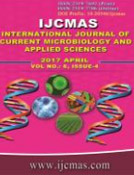


 National Academy of Agricultural Sciences (NAAS)
National Academy of Agricultural Sciences (NAAS)

|
PRINT ISSN : 2319-7692
Online ISSN : 2319-7706 Issues : 12 per year Publisher : Excellent Publishers Email : editorijcmas@gmail.com / submit@ijcmas.com Editor-in-chief: Dr.M.Prakash Index Copernicus ICV 2018: 95.39 NAAS RATING 2020: 5.38 |
A field experiment was conducted at farming system research unit of Krishi Vigyan Kendra, Kandhamal as a part of ongoing effort to collect the data in connection to dry matter accumulation and partitioning in three cultivars of cow pea during growth and development stages in two consecutive summer and Kharif season of the year 2012-13 and 2013-14. The dry matter partitioning had been worked out at 30, 45 and 60 DAS from the stem, leaves and at only 60 DAS from the pods. Results revealed that total dry matter production was higher in the summer season as compare to the rainy season and it increased gradually with the age of the plant. The accumulation of dry matter was more in the pod as compared to leaves and stem. Among the three varieties tested, Maharani showed significant higher accretion of dry matter in the stem (3.38 g plant-1) as compared to Lafa (3.28 g plant-1) and Utkal Manika (3.13 g plant-1) during summer season. In the rainy season Lafa (1.98 g plant-1) yielded highest followed by Maharani (1.09 g plant-1) and Utkal Manika (0.99 g plant-1). Varieties showed the similar trends in the accrual of the dry matter in the leaves and pods, but the amount varies. Maharani accumulate highest during summer season in both leaves and pods 4.60 g plant-1 and 25.26 g plant-1 respectively and lafa performed better in rainy season where accrual of dry matter was 3.01 g plant-1 in the leaves and 19.81 g plant-1 on the pods.
 |
 |
 |
 |
 |